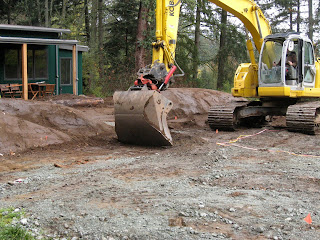Here I have laid out with tape the boundary of the next area Tom will work on, the Gravelbed Garden.
The Backyard Project is made up of a series of interconnecting rooms. This is a concept from Christopher Alexander's Pattern Language research where each room is considered a centre.
It is the use of centers, and the knowledge of the fundamental role that emerging centers play in the evolution of a design, which gives the design process an orderly character, that can succeed, and allows you to keep a clear head while you are doing it, and a clear mind about the long term target, and the immediate action you must take, at each step, step by step, that will guide the design towards a successful end-state.
He explains and expands on this important design principle of centres in his books 'The Nature of Order, volumes 1 to 4.
First Tom works on the pathway which is one of the boundaies defining the Gravelbed Garden room.
Tom lays down and compacts a mixed-size gravel base for the path.
Next he turns to his pile of smaller rocks and starts sorting them by shape. He mentally names the piles according to their function.
Then he begins the slow task of selecting the right rock and putting it in its place. The task demands a lot of focused attention.
Tom was wiped by the end of the day. It took him another half day to finish placing the rocks.
I can see in my mind how it will look when it is planted and surrounded by the other interconnecting rooms. It looks fabulous. Once again Tom did an amazing job.






















































